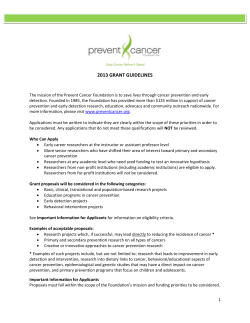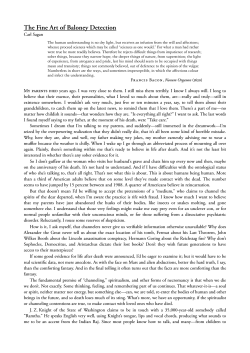
The Road to a Global NCD Agenda Off Big Tobacco's Face)
The Road to a Global NCD Agenda (and How to Keep a Smile Off Big Tobacco's Face) Thomas J. Glynn, PhD American Cancer Society Washington, DC USA Preaching to the Converted Singing to the Choir Carrying Coals to Newcastle Therefore, my primary aim today is to: o Stimulate a discussion around the realities of the NCD issue, and o Stimulate discussion about potential strategies to address NCDs The presentation will be in four parts: 1) Pontificating about the importance of the NCD issue; 2) then, Equivocating about the importance of NCDs in relation to tobacco control; 3) and then Vacillating about both and focusing on the need for a unified pandisease, pan-risk factor front in addressing NCDs; 4) and, finally, Pontificating again, about potential strategies in confronting the NCD issue. When we talk about NCD risk factors, we are essentially talking about the three issues Noncommunicable Diseases 4 Diseases, 4 Modifiable Shared Risk Factors Total deaths around the world: 58 million Total deaths around the world: 58 million Deaths from noncommunicable diseases around the world: 35 million Total deaths around the world: 58 million Deaths from noncommunicable diseases around the world: 35 million Deaths from noncommunicable diseases in developing countries: 28 million Total deaths around the world: 58 million Deaths from noncommunicable diseases around the world: 35 million Deaths from noncommunicable diseases in developing countries: 28 million Deaths from noncommunicable diseases in developing countries which could have been prevented: an estimated 14 million Noncommunicable Diseases Mortality among men and women aged 15-59 years (2004) Noncommunicable Diseases Projected Deaths in 2015 and 2030 Noncommunicable Diseases Death trends (2006-2015) 2005 2006-2015 (cumulative) NCD deaths (millions) NCD deaths (millions) Trend: Death from infectious disease Trend: Death from NCD Africa 10.8 2.5 28 +6% +27% Americas 6.2 4.8 53 -8% +17% Eastern Mediterranean 4.3 2.2 25 -10% +25% Europe 9.8 8.5 88 +7% +4% South-East Asia 14.7 8.0 89 -16% +21% Western Pacific 12.4 9.7 105 +1 +20% Total 58.2 35.7 388 -3% +17% WHO projects that over the next 10 years, the largest increase in deaths from cardiovascular disease, cancer, respiratory disease and diabetes will occur in developing countries. (WHO Chronic Disease Report, 2005) Total deaths (millions) Geographical regions (WHO classification) Noncommunicable Diseases Oil and gas price spike Retrenchment from globalization Asset price collapse NCDs Fiscal crisis Flu pandemic Food crisis Infectious disease http://www.weforum.org/pdf/globalrisk/globalrisks09/global_risks_2009.pdf World Economic Forum: Global Risk Assessment 2009 Noncommunicable Diseases Macro-economic Impact: Lost National Income 2005 2006-2015 (cumulative) Lost national income (billions) Lost national income (billions) Brazil 3 49 China 18 558 India 9 237 Nigeria 0.4 8 Pakistan 1 31 Russian Federation 11 303 Tanzania 0.1 3 Countries WHO: "Heart disease, stroke and diabetes alone are estimated to reduce GDP between 1 to 5% per year in developing countries experiencing rapid economic growth" (WHO Chronic Disease Report, 2005) Lost national income from premature deaths due to heart disease, stroke and diabetes Global Burden of Cancer • 12.7 million new cases of cancer in 2008 • 7.6 million cancer deaths in 2008 • 24.6 million people living with cancer throughout the world Globocan 2008 (IARC), Parkin et al. Global Cancer Incidence 1,800,000 1,600,000 1,400,000 1,200,000 1,000,000 800,000 600,000 400,000 200,000 ca l C er vi er Li v Lu ng B re as C t ol or ec ta l St om ac h Pr os ta te 0 Globocan 2008 (IARC) Global Cancer Mortality 1,400,000 1,200,000 1,000,000 800,000 600,000 400,000 200,000 er ol or ec ta l B re Es as t op ha ge al C er vi ca l C Li v Lu ng St om ac h 0 Globocan 2008 (IARC) Current Burden of Cancer • 56% of new cancer cases occur in developing countries • 63% of cancer deaths occur in developing countries • There are significant differences in the pattern of cancer from region to region • For example, cervical and liver cancers are more common in developing countries; prostate and colorectal cancers in developed countries Globocan 2008 (IARC) Most Common Cancers, Developing World Male Lung – 612,544 Stomach – 466,859 Liver – 440,654 United States 1. Prostate 2. Lung 3. Colorectum Female Breast – 691,281 Cervical – 452,902 Lung – 271,954 United States 1. Breast 2. Lung 3. Colorectum Globocan 2008 (IARC) Deadliest Cancers, Developing World Male Lung – 539,035 Liver – 402,862 Stomach – 353,540 United States 1. Lung 2. Prostate 3. Colorectum Female Breast – 268,879 Cervical – 241,724 Lung – 239,013 United States 1. Lung 2. Breast 3. Colorectum Globocan 2008 (IARC) Cancer Cases and Deaths Global Economic Burden of Cancer = US $895 Billion/ 1.5% of Global GDP Source: American Cancer Society/LiveStrong Foundation, 2010 Just before the end of the Pontificating phase, a word about why NCDs have become, so recently, a significant global issue... Transitions • Demographic Transition: A change in the population dynamics of a country as it moves from high fertility and premature mortality rates to lower fertility and premature mortality rates • Epidemiologic Transition: A transition from predominance of infectious diseases to chronic, degenerative, or man-made diseases; also a transition from cancers caused by infectious agents to those related to “modifiable” risk factors Transitions * Growing wealth and economic opportunity, better nutrition and housing, safer food and water, Improved hygiene and sanitation, changes in reproductive practices, and increased use of antibiotics and vaccines have led to ... * Better control of communicable diseases, reductions in childhood mortality, increases in life expectancy, and ultimately ... Growing and aging populations. Evolution of Population Pyramid United States 1950-2050 Men The population pyramid for China unfolds over a 100 (1950-2050) year period and the aging of the population becomes quite obvious. For the period 1950 to 1995 the pyramid is based on population estimates of the UN Population Division; the data for 2000 to 2050 are from the most recent medium variant UN population projection. World Population Population (2005) 6.454 billion 3.245 Billion 3.209 Billion World Population Population (2030) 8.130 billion 4.068 Billion 4.062 Billion Transitions • Simultaneously, the forces of globalization have facilitated the broad and aggressive marketing of tobacco products, resulting in the growth of tobacco–use and tobacco-caused morbidity and mortality (1.25 billion smokers). • And increased consumption of high–calorie foods, driven by a global food industry, along with reductions in physical activity, caused by changes in the workplace, are contributing to increases in overweight and obesity and the diseases associated with them (1.6 billion overweight, 1 in 4, 400 million obese). - Tobacco Atlas 3rd ed; WHO And, less physical activity Beijing ca 1980 Beijing today Transitions Population Growth WHO, Global Health Risks, 2009 WEF: Global Risks Landscape 2010 droughts terrorism Now, on to some Vacillation Having made the argument that NCDs should be at the top of the global health agenda, is there danger that tobacco - the risk factor common to the four major NCDs and the cause of more death and disability than any other - will be swept into the background? "Don't Forget Tobacco" Steven A. Schroeder, M.D., and Kenneth E. Warner, Ph.D. N Engl J Med 2010; 363:201-204 The Disease Consequences of Tobacco Use Are Universal Tobacco Related Cancers • • • • • • • • • Oral cavity and pharynx Esophagus Larynx Lung, trachea and bronchus Urinary bladder Renal pelvis Uterine cervix Pancreas Kidney Tobacco Related Cardiovascular Diseases • • • • • • Hypertension Ischemic heart disease Atherosclerosis Pulmonary heart disease Aortic aneurysm Stroke Tobacco Related Respiratory Diseases • • • • Chronic bronchitis Emphysema Asthma Pneumonia Tobacco Related Pediatric Diseases • Low birth weight • Respiratory distress syndrome • Sudden infant death syndrome Secondhand Tobacco Smoke Problems • Heart Disease • Lung cancer • Asthma attacks • Bronchitis and pneumonia (especially children) • Coughs and croup (especially children) • Middle ear infections (children) Economic Effects of Tobacco Use By 2010, the WHO estimates the annual global cost of tobacco to be US$500 billion – a figure higher than the GDP of 174 of 192 UN members Smoking-related costs can Smokingcontribute up to 15% of total healthhealthcare costs in developed countries Japanese male smokers, for example, incur 11% more medical costs than never smokers and have increased inpatient medicalmedical-care costs 33% higher in smokers than never smokers Economic Effects of Tobacco Use (continued) As much as ten percent of family income in some parts of the world is spent on tobacco, limiting needed expenditures on food, clothing, education, and shelter A 1996 study – 10 years ago – estimated that total annual medical and social costs of tobacco use in Hong Kong were oneone-quarter of the total healthcare budget – and prevalence has risen since then For nearly 50% of the world’s population, a pack of Marlboros costs approximately half of a family’s daily income The Tobacco Issue is not "Solved" or "Over" - Progress has been made, but ... o Tobacco Use Reductions in HighIncome Countries Have Slowed in Recent Years o And... millions Tobacco deaths in the Industrialized and Developing World, 2000 and 2030 10 9 8 7 6 5 4 3 2 1 0 Industrialized countries Developing countries 2.1 3 7 2.1 2000 2030 While tobaccorelated deaths will only increase slightly in the industrialized world during the next 30 years, they will more than triple in the developing world. “Tobacco use is unlike other threats to global health. Infectious diseases do not employ multinational public relations firms. There are no front groups to promote the spread of cholera. Mosquitoes have no lobbyists.” WHO Zeltner Report, 2000 Why Hasn’t Tobacco Control Received the Global Attention it Needs? 1. Tobacco use is viewed as a personal choice and a personal failing 2. Most victims of tobacco-related disease die and disappear quickly 3. Families and victims are often ashamed to discuss their tobacco use 4. The tobacco pandemic has developed slowly and insidiously Why Hasn’t Tobacco Control Received the Global Attention it Needs? (continued) 5. Tobacco is old news 6. No strong tobacco control advocacy groups have arisen 7. The global effects of tobacco use – health and economic – are not well known 8. The multinational tobacco companies have controlled the playing field. 2 million 1 million 0 3 million 4 million High blood pressure High blood glucose Physical inactivity Unsafe sex Underweight High cholesterol Overweight and obesity Alcohol use Indoor smoke from solid fuels 6 million Tobacco use 5 million Unsafe water, sanitation, hygiene Low fruit and vegetable intake Sub-optimal breastfeeding Urban outdoor air pollution Occupational risks Vitamin A deficiency Zinc deficiency Unsafe health care injections Iron deficiency Illicit drug use Unmet contraceptive need Global climate change Lead exposure Child sexual abuse New perspectives on the NCD problem Attributable deaths in developing countries by risk factor 7 million Millennium Development Goals Goal 1 Goal 2 Goal 3 Goal 4 Goal 5 Goal 6 Goal 7 Goal 8 Eradicate extreme poverty and hunger. Achieve universal primary education. Promote gender equality and empower women. Reduce child mortality. Improve maternal health. Combat HIV/AIDS, malaria and other diseases. Ensure environmental sustainability Develop a global partnership for development. Tobacco control relevant to most aspects of development Tobacco control is relevant in achieving each of the eight United Nations Millennium Development Goals (MDG) • Health development: Non-communicable diseases (NCDs), TB, HIV/AIDS, maternal and child health • Economic development: poverty reduction, health systems financing, food security, environmental sustainability, rural/agricultural development • Social development: gender equality, child labour/education Now, finally, some EQUIVOCATION Three Threats to Raising NCDs to the Top of the Global Health Agenda: 1. The Quandary Properly and Effectively Addressing NCDs will not Work if a Disease and/or Risk Factor Hierarchy, or Caste System, is Allowed to Develop Tobacco control relevant to most aspects of development Tobacco control is relevant in achieving each of the eight United Nations Millennium Development Goals (MDG) • Health development: Non-communicable diseases (NCDs), TB, HIV/AIDS, maternal and child health • Economic development: poverty reduction, health systems financing, food security, environmental sustainability, rural/agricultural development • Social development: gender equality, child labour/education World Health Statistics 2007, World Health Organization, https://www.who.int/whosis/whostat2007_10highlights.pdf Global NCD Coalitions o NCDnet o NCD Alliance o Global Alliance for Chronic Disease and many other organizations (e.g. C3, OxHa, GI, PHII, BI, IDRC, etc.) 2. The Koplan-Yach Cautionary Principle: Arguments Against an NCD Focus o "Life expectancy in our country is too short to worry about NCDs" o “ NCD data only apply to high-income countries" o "The healthcare system in our country is in disarray, so we can't deal with NCDs" o "We have more immediate problems, both health-related and political, to address" o "NCD data are merely projections, so maybe they will not come to pass" 2. Koplan-Yach Cautionary Principle: (continued) o "Our Health Ministry and politicians are not aware of the scope of the NCD issue" o "NCDs are the diseases of the rich, not the majority of people in my country" o "NCDs are the fault of the individual, so should receive less attention" o "NCDs are too expensive to prevent and treat" o "We do not have the experience and knowledge in my country to prevent and treat NCDs" 3. The Global Health/Development Bureaucracy The NCD movement will need to carefully maneuver through the global health/development bureaucracy, which can be both a help and a hindrance. UN NCD High level meeting By the end of 2010 Modalities resolution CARICOM Pres of GA Next month? GA Member states 2 co-facilitators (one likely to be CARICOM) Office of Sec General Draft outcome document UN agency – WHO? Report on NCDs at GA 65th session USG Civil society UNDESA Dept for General Assembly and Conf management 2011 NCD Summit – Sep 2011 Side events Final outcome document “A public health emergency in slow motion” Ban Ki-moon, UN Secretary General But...a final, brief PONTIFICATION The Potential for Success in Addressing NCDs on a Global Scale abounds... 1. Global NCD Coalitions o NCDnet o NCD Alliance o Global Alliance for Chronic Disease and many other organizations (e.g. C3, OxHa, GI, PHII, BI, IDRC, etc.) 2. Strength of the Data/Science 3. Lessons Learned from the Communicable/Infectious Disease Experience 4. Specificity of the NCD Needs/ Goals, e.g. • Successful September, 2001 U.N. NCD Conference • Governments to be accountable/measured on NCD plans/actions • Globally agreed approaches to NCD prevention/treatment/care • Specific resources allotted to deliver NCD interventions • NCDs in MDG successor goals • Provide policymakers with NCD evidence - health and economic • Elevation of NCDs on national/regional health agendas • Expanded NCD research “Richard Doll was both a great doctor and the greatest epidemiologist of our time.” Guardian obituary, 2005 (Photo at BMJ press conference on 5050-year results, 2004) ©2009 American Cancer Society, Inc. No.0052.19
© Copyright 2025

















